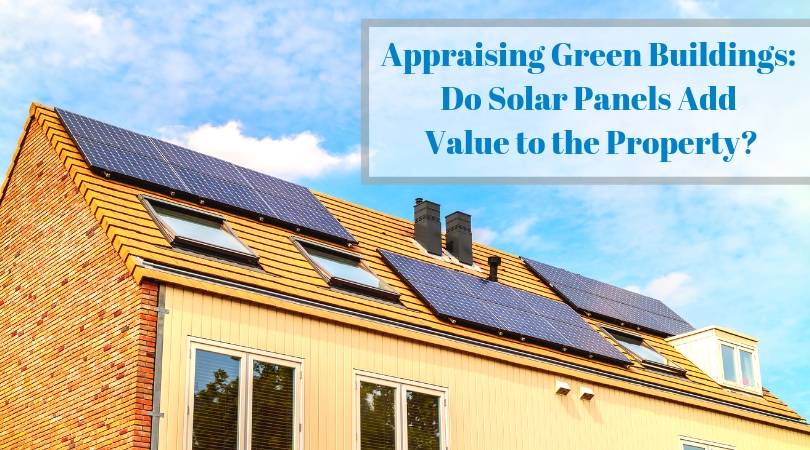From eliminating disposable straws to banning single-use plastic bags, reducing human impact on the environment is at the forefront of many citizens’ minds in recent years. As a result, the real estate industry is progressively adopting ecology-minded trends, resulting in the gradual emergence of green buildings (both commercial and residential) across the country. Green buildings are defined as properties that use renewable energy and efficient building materials in their operation, construction, and design to create positive impacts on human and environmental health. One of the key technologies that embody this growing shift towards sustainability is Photo Voltaic (PV), otherwise known as solar panels. Although we can rejoice that the green building movement is becoming more mainstream, the question of whether or not this energy source and other green features add value to a property is still up in the air.
Property owners are often surprised when the time comes to estimate the fair market value of their green building. Many appraisers believe that these green features, although expensive, add little value to the property, while potential buyers find these features appealing and valuable. This dichotomy between the perceived value of the property and the one reflected in the appraisal can lead to many issues when selling or refinancing. Let’s explore how solar panels and other green features add value to real property.
Solar Panels and Other Green Features Are a Good Investment
The good news for owners of green buildings is that several studies demonstrate that they tend to sell for more than the average property. In the residential world, a 2015 report from the Lawrence Berkeley National Laboratory concludes that houses equipped with solar panels sell for $14,329 more on average than a non-solar comparable property, which represents a 3.74% increase. Other recent reports support these findings, with green homes selling, on average, for 2.19% to over 8% more than traditional buildings, depending on the property’s features and location.
Given the significant investment that these features represent, particularly if they are added once the building is already built, the previously mentioned numbers seem low. However, the most compelling argument for installing solar panels or other eco-conscious elements in a building remains that they pay for themselves in the long run, as the owners save money every month on their energy bill. For commercial buildings, green features like solar panels can significantly decrease their operating expenses. Additionally, tax credits for commercial and residential buildings are an added incentive for those who install energy-efficient products or renewable energy systems in their property. Finally, as technology progresses, these elements will become not only more efficient but also more affordable.
With analysts predicting that energy prices will continue rising in the coming years, it is likely that green features, such as photo voltaic, will become more widespread and something that buyers will demand and be willing to pay more money for.
The Other Side of the Coin: The Appraisal Process Doesn’t Always Reflect the Contributed Value of Green Features
Sometimes, appraisals do not reflect the perceived value of these improvements, to the dismay of building owners.
This is due in part to the fact that, to establish the market value of a property, appraisers must present in their report comparables with similar features to support the opinion of value. Although green buildings are becoming more popular in some markets, often at the initiative of the state—for example, California’s goal is to have 33% renewable energy by 2020 and 50% renewable by 2030—they are still scarce in many parts of the country. In the absence of green comparables, appraisers have little evidence to conclude that solar panels and other features add value to a building.
To objectively derive the additional value that solar panels contribute the property, appraisers turn to the discounted cash flow (DCF) method. DCF consider the present value of the future cash flows (or savings) that the array will generate over a given period of time.
While DCF is useful, some appraisers lack the specialized training needed to fully consider the value of these features. They have little incentive to educate themselves on the subject, especially if green buildings are not prevalent in their area and if the chances that they will need to value one are slim. Appraisers specializing in green buildings exist, but they can be few and far between in geographic areas where green technologies have yet to catch up.
Finally, with the constant changes in technology, the information required by an appraiser to evaluate the added value of each feature accurately is not always available. Some features are not visible to the untrained eye, and unless the owner informs the appraiser of which elements are present on the property and their characteristics, he or she may easily miss them.
Keeping Up with Green Trends: Appraisers Are Catching Up Quickly
Nevertheless, with more green buildings constructed, bought and sold every day, the issue of finding appropriate comparables will diminish over time. Moreover, the appraising community is making a conscious effort to catch up with these trends. Companies are offering specialized training to educate appraisers on the different features to take into consideration when valuing a building and how to incorporate them in an appraisal.
The Appraisal Institute (AI), which is the largest professional association of real estate appraisers in the United States, released “The Residential Green and Energy Efficient Addendum” in 2011 (updated in 2017) to help appraisers communicate the green features of a property transparently and efficiently in the appraisers’ reports. AI is also at the forefront of green building education for appraisers with its Valuation of Sustainable Buildings Professional Development Program.
How can building owners ensure that green features are reviewed in an appraisal?
Appraising a new feature is always a challenge, and it can take time for the perceived value to be reflected in the appraisal, based on sales comparison. Builders, homeowners, and real estate agents should prepare to provide the appraiser with all the documentation necessary to identify the characteristics of each green feature and prove that these features contribute to the value of the property by saving money every month. Detailed technical specifications, HERS rating, comparative energy bills, etc., help the appraiser to support the added value for each high-performing and energy-efficient element.
Have you encountered a situation where a building’s features were not reflected in an appraisal? How was the situation resolved?


